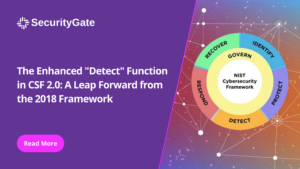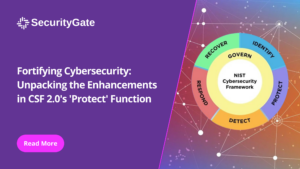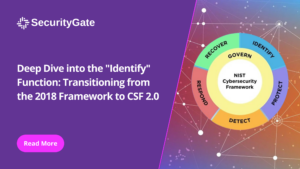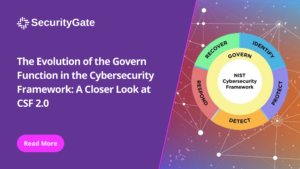In the fast-evolving world of cybersecurity, staying ahead of threats requires constant vigilance and a robust framework for managing risk. The National Institute of Standards and Technology’s (NIST) Cybersecurity Framework (CSF) has long stood as a beacon for organizations seeking to fortify their cyber defenses.
With the release of CSF 2.0, NIST has introduced significant updates that reflect the latest cybersecurity practices and the shifting nature of digital threats, including the notable addition of a new core function: “Govern.”
This blog series aims to help organizations navigate these changes and understand their implications, focusing on each of CSF 2.0’s core functions: Govern, Identify, Protect, Detect, Respond, and Recover.
Why CSF 2.0 Matters
The transition from the 2018 framework to CSF 2.0 isn’t just an update; it’s a comprehensive overhaul considering the dramatic shifts in cybersecurity over the past few years. From the proliferation of sophisticated cyber threats to the increasing complexity of digital ecosystems, CSF 2.0 offers a revised and expanded set of guidelines designed to help organizations of all sizes and sectors strengthen their cybersecurity posture.
What to Expect from This Series
Our series aims to provide a thorough analysis of CSF 2.0, breaking down the updates to each core function and offering actionable insights for implementation. Here’s a sneak peek at what we’ll cover:
– The Introduction of “Govern”: A deep dive into CSF 2.0’s new “Govern” function, exploring its significance and how it integrates with existing cybersecurity governance structures.
– Enhancements in “Identity”: An examination of how CSF 2.0 expands the Identify function to better capture organizational assets and risks.
– Refinements in “Protect”: A look at the updated Protect function, focusing on identity management, data security, and the introduction of platform security.
– Advancements in “Detect”: Analysis of the enhanced Detect function, emphasizing continuous monitoring and the importance of adverse event analysis.
– Strategic Updates to “Respond”: An exploration of the updated Respond function, highlighting incident management and the critical role of communication.
– Bolstering “Recover”: A review of the enhanced Recover function, focusing on the importance of recovery planning execution and communication.
Tailoring the Insights
Whether you’re a cybersecurity veteran or new to the field, this series is designed to provide valuable insights into CSF 2.0’s framework and how it can be applied to improve your organization’s cyber resilience. We’ll offer practical advice, best practices, and considerations for integrating the framework’s components into your cybersecurity strategy.
Join the Conversation
As we embark on this journey through CSF 2.0, we invite you to engage with the content, share your experiences, and join the conversation around cybersecurity best practices. Each post in this series is not just an exploration of the framework but an invitation to dialogue about how we can collectively enhance our cybersecurity defenses in an increasingly digital world.
Stay tuned for our next blog post about the newly introduced “Govern” function, setting the stage for a comprehensive understanding of CSF 2.0 and its impact on the cybersecurity landscape.
Subscribe to our weekly newsletter for more related content.






